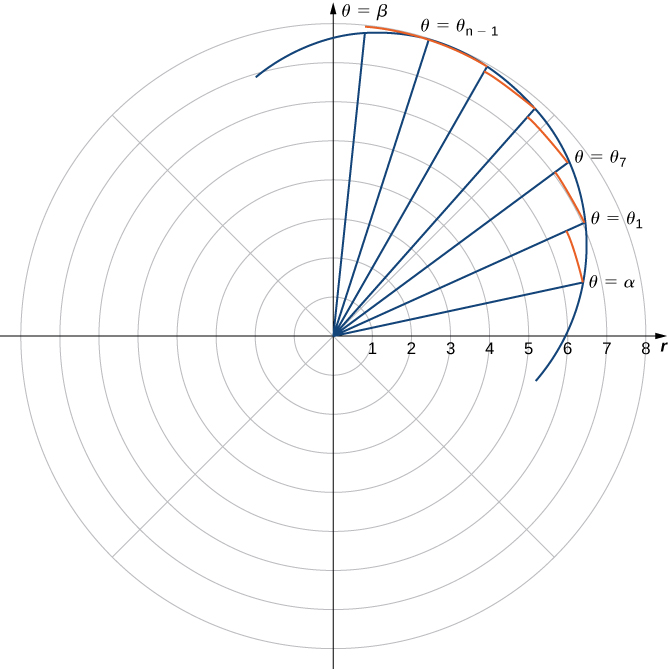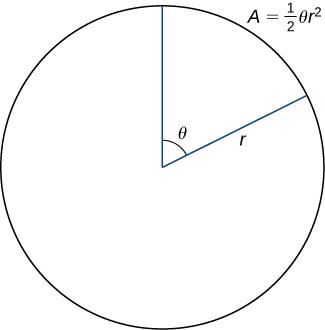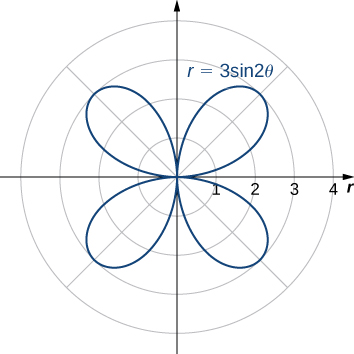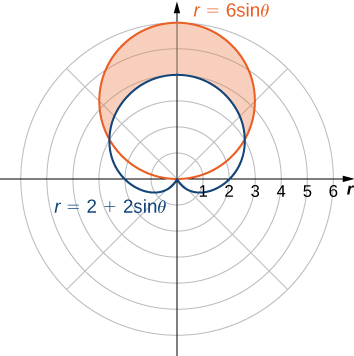
In the rectangular coordinate system, the definite integral provides a way to calculate the area under a curve. In particular, if we have a function
defined from
to
where
on this interval, the area between the curve and the x-axis is given by
This fact, along with the formula for evaluating this integral, is summarized in the Fundamental Theorem of Calculus. Similarly, the arc length of this curve is given by
In this section, we study analogous formulas for area and arc length in the polar coordinate system.
We have studied the formulas for area under a curve defined in rectangular coordinates and parametrically defined curves. Now we turn our attention to deriving a formula for the area of a region bounded by a polar curve. Recall that the proof of the Fundamental Theorem of Calculus used the concept of a Riemann sum to approximate the area under a curve by using rectangles. For polar curves we use the Riemann sum again, but the rectangles are replaced by sectors of a circle.
Consider a curve defined by the function
where
Our first step is to partition the interval
into n equal-width subintervals. The width of each subinterval is given by the formula
and the ith partition point
is given by the formula
Each partition point
defines a line with slope
passing through the pole as shown in the following graph.

The line segments are connected by arcs of constant radius. This defines sectors whose areas can be calculated by using a geometric formula. The area of each sector is then used to approximate the area between successive line segments. We then sum the areas of the sectors to approximate the total area. This approach gives a Riemann sum approximation for the total area. The formula for the area of a sector of a circle is illustrated in the following figure.

Recall that the area of a circle is
When measuring angles in radians, 360 degrees is equal to
radians. Therefore a fraction of a circle can be measured by the central angle
The fraction of the circle is given by
so the area of the sector is this fraction multiplied by the total area:
Since the radius of a typical sector in [link] is given by
the area of the ith sector is given by
Therefore a Riemann sum that approximates the area is given by
We take the limit as
to get the exact area:
This gives the following theorem.
Suppose
is continuous and nonnegative on the interval
with
The area of the region bounded by the graph of
between the radial lines
and
is
Find the area of one petal of the rose defined by the equation
The graph of
follows.

When
we have
The next value for which
is
This can be seen by solving the equation
for
Therefore the values
to
trace out the first petal of the rose. To find the area inside this petal, use [link] with
and
To evaluate this integral, use the formula
with
Find the area inside the cardioid defined by the equation
Use [link]. Be sure to determine the correct limits of integration before evaluating.
[link] involved finding the area inside one curve. We can also use [link] to find the area between two polar curves. However, we often need to find the points of intersection of the curves and determine which function defines the outer curve or the inner curve between these two points.
Find the area outside the cardioid
and inside the circle
First draw a graph containing both curves as shown.

To determine the limits of integration, first find the points of intersection by setting the two functions equal to each other and solving for
This gives the solutions
and
which are the limits of integration. The circle
is the red graph, which is the outer function, and the cardioid
is the blue graph, which is the inner function. To calculate the area between the curves, start with the area inside the circle between
and
then subtract the area inside the cardioid between
and
Find the area inside the circle
and outside the circle
Use [link] and take advantage of symmetry.
In [link] we found the area inside the circle and outside the cardioid by first finding their intersection points. Notice that solving the equation directly for
yielded two solutions:
and
However, in the graph there are three intersection points. The third intersection point is the origin. The reason why this point did not show up as a solution is because the origin is on both graphs but for different values of
For example, for the cardioid we get
so the values for
that solve this equation are
where n is any integer. For the circle we get
The solutions to this equation are of the form
for any integer value of n. These two solution sets have no points in common. Regardless of this fact, the curves intersect at the origin. This case must always be taken into consideration.
Here we derive a formula for the arc length of a curve defined in polar coordinates.
In rectangular coordinates, the arc length of a parameterized curve
for
is given by
In polar coordinates we define the curve by the equation
where
In order to adapt the arc length formula for a polar curve, we use the equations
and we replace the parameter t by
Then
We replace
by
and the lower and upper limits of integration are
and
respectively. Then the arc length formula becomes
This gives us the following theorem.
Let
be a function whose derivative is continuous on an interval
The length of the graph of
from
to
is
Find the arc length of the cardioid
When
Furthermore, as
goes from
to
the cardioid is traced out exactly once. Therefore these are the limits of integration. Using
and
[link] becomes
Next, using the identity
add 1 to both sides and multiply by 2. This gives
Substituting
gives
so the integral becomes
The absolute value is necessary because the cosine is negative for some values in its domain. To resolve this issue, change the limits from
to
and double the answer. This strategy works because cosine is positive between
and
Thus,
Find the total arc length of
Use [link]. To determine the correct limits, make a table of values.
with
is given by the integral
with
is given by the integral
For the following exercises, determine a definite integral that represents the area.
Region enclosed by
Region enclosed by
Region in the first quadrant within the cardioid
Region enclosed by one petal of
Region enclosed by one petal of
Region below the polar axis and enclosed by
Region in the first quadrant enclosed by
Region enclosed by the inner loop of
Region enclosed by the inner loop of
Region enclosed by
and outside the inner loop
Region common to
Region common to
Region common to
For the following exercises, find the area of the described region.
Enclosed by
Above the polar axis enclosed by
Below the polar axis and enclosed by
Enclosed by one petal of
Enclosed by one petal of
Enclosed by
Enclosed by the inner loop of
Enclosed by
and outside the inner loop
Common interior of
Common interior of
Common interior of
Inside
and outside
Common interior of
For the following exercises, find a definite integral that represents the arc length.
on the interval
For the following exercises, find the length of the curve over the given interval.
32
For the following exercises, use the integration capabilities of a calculator to approximate the length of the curve.
[T]
6.238
[T]
[T]
2
[T]
[T]
4.39
For the following exercises, use the familiar formula from geometry to find the area of the region described and then confirm by using the definite integral.
For the following exercises, use the familiar formula from geometry to find the length of the curve and then confirm using the definite integral.
Verify that if
then
For the following exercises, find the slope of a tangent line to a polar curve
Let
and
so the polar equation
is now written in parametric form.
Use the definition of the derivative
and the product rule to derive the derivative of a polar equation.
The slope is
The slope is 0.
tips of the leaves
At
the slope is undefined. At
the slope is 0.
tips of the leaves
The slope is undefined at
Find the points on the interval
at which the cardioid
has a vertical or horizontal tangent line.
For the cardioid
find the slope of the tangent line when
Slope = −1.
For the following exercises, find the slope of the tangent line to the given polar curve at the point given by the value of
Slope is
[T] Use technology:
at
Calculator answer: −0.836.
For the following exercises, find the points at which the following polar curves have a horizontal or vertical tangent line.
Horizontal tangent at
The cardioid
Horizontal tangents at
Vertical tangents at
and also at the pole
Show that the curve
(called a cissoid of Diocles) has the line
as a vertical asymptote.

You can also download for free at http://cnx.org/contents/9a1df55a-b167-4736-b5ad-15d996704270@5.1
Attribution: